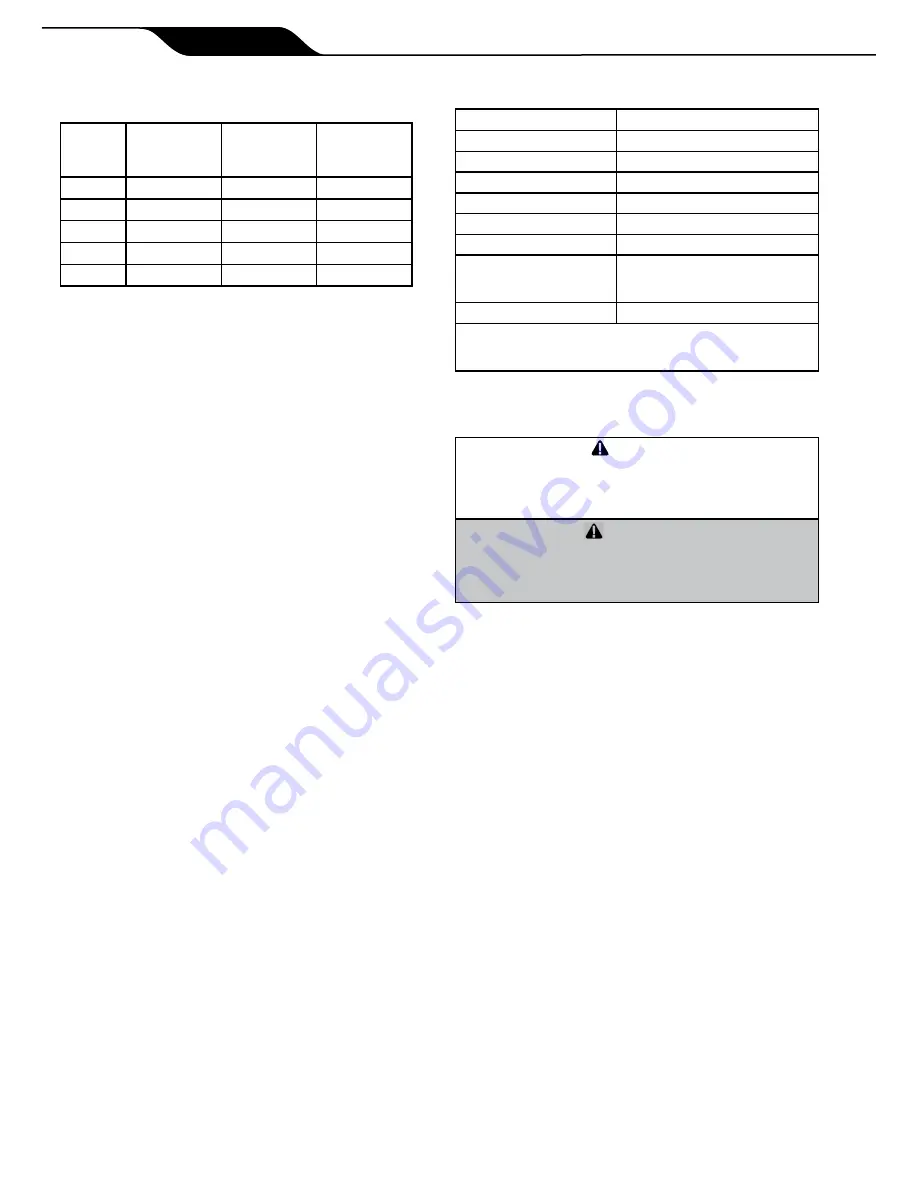
Page 28
ENGLISH
Jandy® Legacy™ Model LRZM Pool/Spa Heater by Zodiac®
|
Installation and Operation Manual
table 6. Water temperature Rise and Flow Rates
(Measured at Return Header)
Model
Minimum
Temp Rise,
°F (°C)
Maximum
Temp Rise,
°F (°C)
Minimum
System Flow
GPM (lps)
125
7 (4)
10 (5)
30 (1.9)
175
10 (6)
13 (7)
30 (1.9)
250
16 (9)
20 (11)
30 (1.9)
325
20 (11)
26 (14)
30 (1.9)
400
23 (13)
29 (16)
30 (1.9)
In a system without external bypass, it may be
necessary to make changes. If temperature rise is too
low, a manual bypass must be installed. If tempera-
ture rise is too high, there is inadequate flow, possibly
requiring a change to the piping system or a larger
pump. Before proceeding with either remedy, verify
proper heater operation. Low gas input results in low
temperature rise and vice-versa. A problem with the
heater internal bypass assembly also affects measured
temperature rise.
Section 8. Maintenance
8.1
Water chemistry
The mineral content of swimming pool water
increases daily due to natural evaporation and the
addition of sanitizing chemicals. If the mineral concen-
tration in the pool gets too high, the excess miner-
als will deposit on the walls of the pool, in the filter
system, and in the heater tubes.
The proper chemical balance in spa water is more
critical than in a swimming pool heater operation. Due
to the spa's size, high water temperature and heavy
usage, chemical values in a spa can vary greatly. This
chemical imbalance can result in unsanitary water
conditions, and affect the life of the heater.
Proper chemical balances are necessary for
sanitary bathing conditions as well as ensuring your
heater's long life. Kits are available from your local
pool supply dealer for making the various tests for
mineral content. One of these kits will detect copper in
the system. This is usually a warning that corrosion is
taking place, possibly due to a low pH value combined
with other chemistry problems. The condition can
be corrected by changing the spa water and closely
monitoring the pH factor and chemical properties of
the water. Be sure to keep your chemical levels within
the values indicated in Table 7.
Zodiac Pool Systems,
Inc. does not warrant heat exchangers damaged by
corrosive chemical levels or excess dissolved solids
in pool or spa water.
For spas, it is also necessary to perform water
changes in addition to chemical treatment. It is recom-
mended to change the spa water every 60 days for light
usage and every 30 days if usage is heavy.
table 7. optimal Water chemistry Ranges*
test
Recommended Level
Free Chlorine
1.0 to 3.0 ppm
Bromine
2.0 to 4.0 ppm
pH
7.2 to 7.8 (ideal range of 7.4 to 7.6)
Total Alkalinity (TA)
80 to 120 ppm
Calcium Hardness (CH)
175 to 400 ppm
Cyanuric Acid
50 to 75 ppm
Total Dissolved Solids
(TDS)
1000 to 2000 ppm (Excluding dis-
solved NaCl from a Salt Chlorine
Generator)
Copper
0 ppm
* Concentration levels taken from "Basic Pool and Spa
Technology" published by APSP (Association of Pool and Spa
Professionals).
8.2
Seasonal care
cautioN
Do not operate this heater outdoors at temperatures
below 20 degrees Fahrenheit (°F) (-7 degrees
Celsius [°C]).
atteNtioN
Ne faites pas fonctionner cet appareil à l’extérieur à
des températures inférieures à 20 degrés Fahren-
heit (
o
F) (-7 degrés Celsius [
o
C]).
8.2.1 Spring and Fall operation
During periods when the pool is only going to be
used occasionally, turn the temperature control down
to the MIN setting. This prevents the pool water from
becoming chilled, and minimizes the time required to
raise the pool water back up to the desired tempera-
ture.
In areas subject to only short freeze periods, turn
off the heater and run the pump continuously for the
length of the freeze period.
If the heater is not going to be used for a long
period of time, shut it down completely. Follow the
instructions found on the inside of the heater, or refer
to Figure 18 of this manual.
8.2.2 Winterizing
In areas where freezing temperatures occur in
winter, and the pool or spa will not be used, have your
service technician perform the following steps:
1. Turn off the main gas supply valve to the heater,
outside the heater jacket.
2. Remove heater door.
3. Shut down the heater following the shutdown
instructions found on the inside of the heater or
refer to Figure 18 of this manual.
Summary of Contents for Jandy Legacy LRZ Millivolt
Page 2: ......
















































